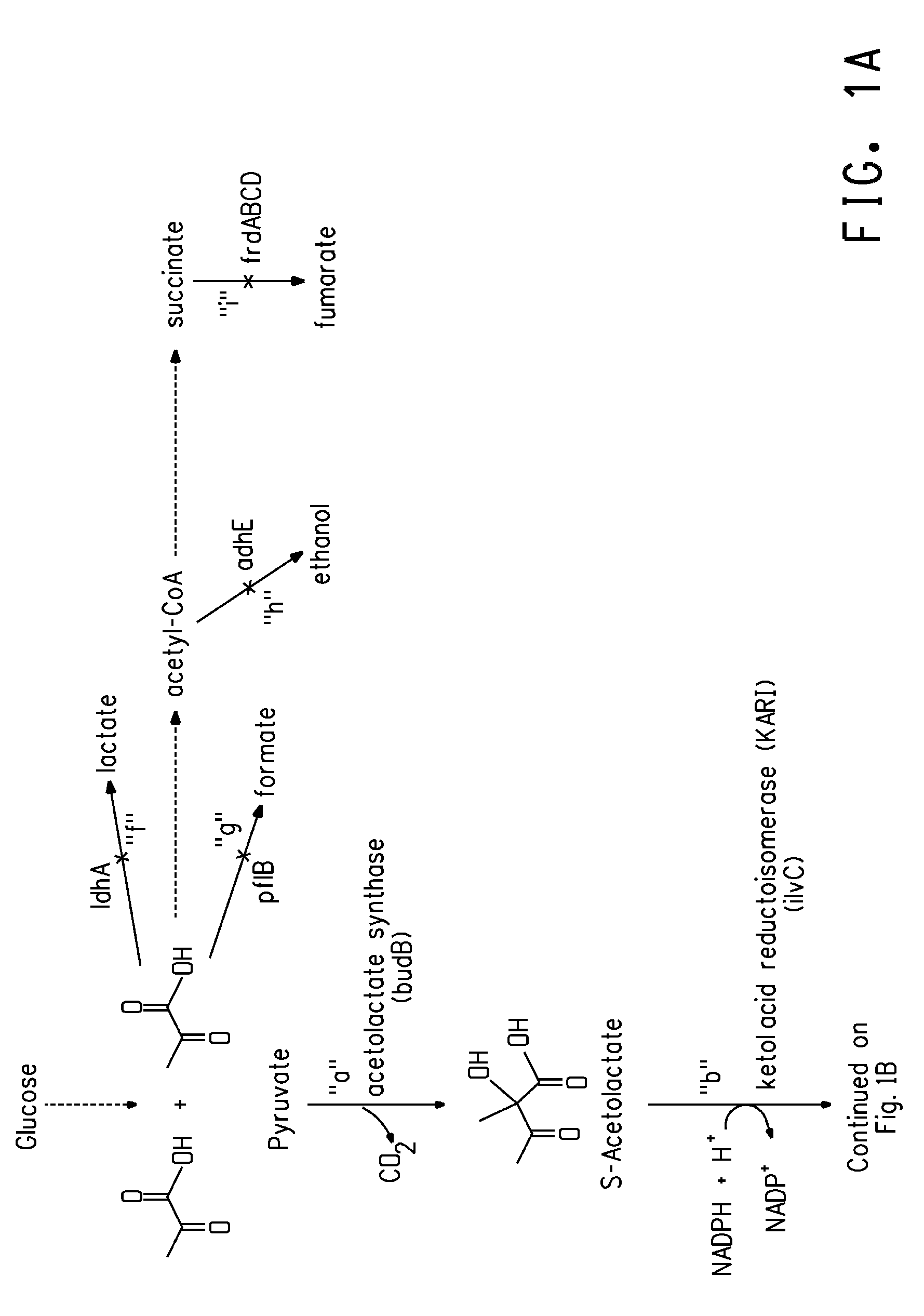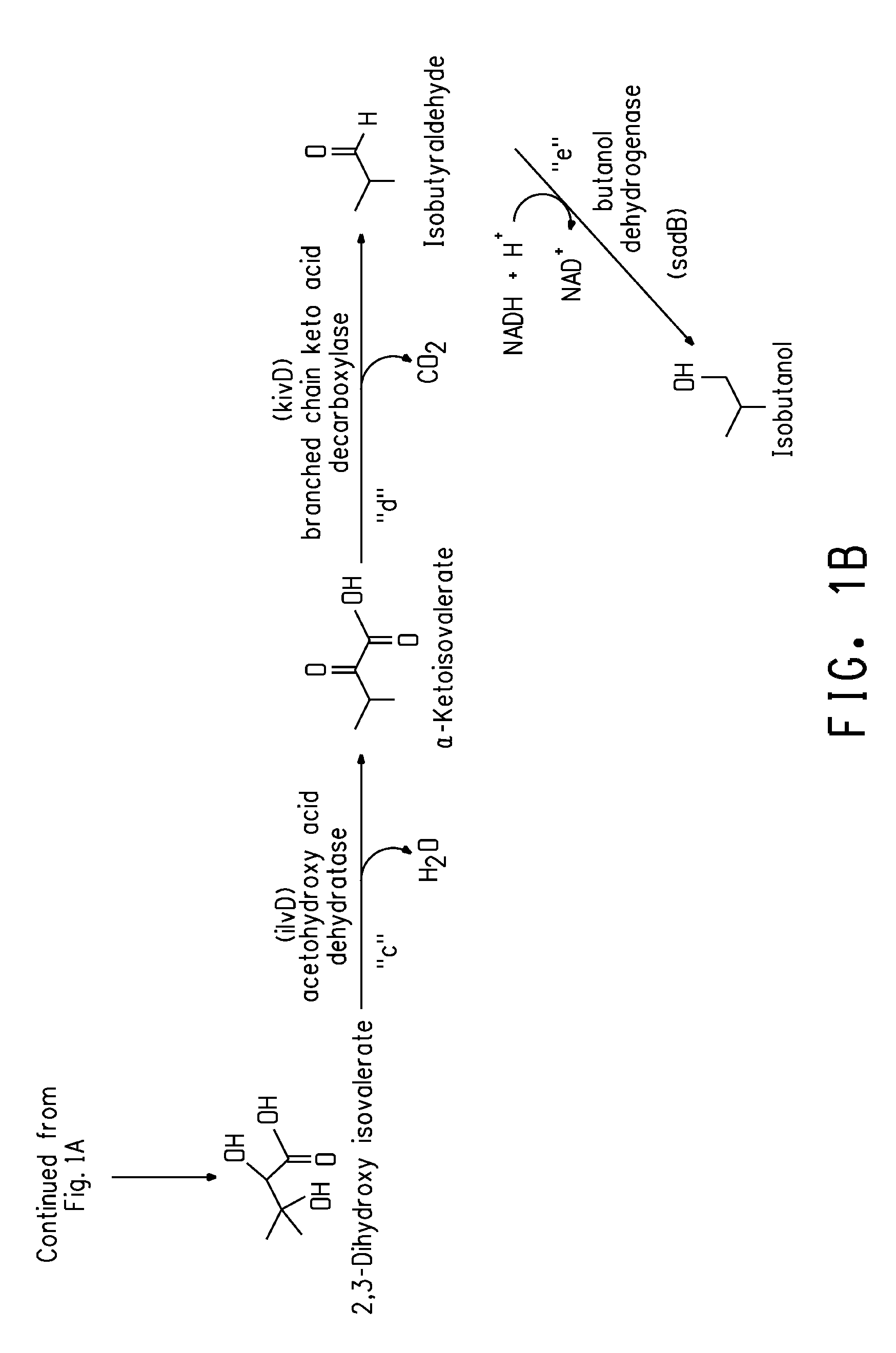Deletion mutants for the production of isobutanol
a technology of isobutanol and deletion mutants, which is applied in the field of microorganisms and molecular biology, can solve the problems of compromising the use of cells as production hosts and the likelihood of poor host cell metabolism, and achieve the effect of improving the rate of isobutanol
- Summary
- Abstract
- Description
- Claims
- Application Information
AI Technical Summary
Benefits of technology
Problems solved by technology
Method used
Image
Examples
example 1
Construction of an E. coli Strain Having Deletions of pfIB, frdB, IdhA, and adhE Genes
[0153]This example describes engineering of an E. coli strain in which four genes were inactivated. The Keio collection of E. coli strains (Baba et al., Mol. Syst. Biol., 2:1-11, 2006) was used for production of the 4KO E. coli (four-knock out). The Keio collection is a library of single gene knockouts created in strain E. coli BW25113 by the method of Datsenko and Wanner (Datsenko, K. A. & Wanner, B. L., Proc Natl Acad Sci., USA, 97: 6640-6645, 2000). In the collection, each deleted gene was replaced with a FRT-flanked kanamycin marker that was removable by Flp recombinase. The 4KO E. coli strain was constructed by moving the knockout-kanamycin marker from the Keio donor strain by P1 transduction to a recipient strain. After each P1 transduction to produce a knockout, the kanamycin marker was removed by Flp recombinase. This markerless strain acted as the new donor strain for the next P1 transduct...
example 2
Construction of an E. coli Production Host Containing an Isobutanol Biosynthetic Pathway and Deletions of pfIB, frdB, IdhA, and adhE Genes
[0164]A DNA fragment encoding a butanol dehydrogenase (DNA SEQ ID NO:9; protein SEQ ID NO: 10) from Achromobacter xylosoxidans was amplified from A. xylosoxidans genomic DNA using standard conditions. The DNA was prepared using a Gentra Puregene kit (Gentra Systems, Inc., Minneapolis, Minn.; catalog number D-5500A) following the recommended protocol for gram negative microorganisms. PCR amplification was done using forward and reverse primers N473 and N469 (SEQ ID NOs: 44 and 45), respectively with Phusion high Fidelity DNA Polymerase (New England Biolabs, Beverly, Mass.). The PCR product was TOPO-Blunt cloned into pCR4 BLUNT (Invitrogen) to produce pCR4Blunt::sadB, which was transformed into E. coli Mach-1 cells. Plasmid was subsequently isolated from four clones, and the sequence verified.
[0165]The sadB coding region was then cloned into the vec...
example 3
Production of Isobutanol by Recombinant E. coli Using Extractive Fermentation
[0168]The purpose of this Example is to demonstrate production of isobutanol by E. coli strain NGCI-031, constructed as described herein above. All seed cultures for inoculum preparation were grown in the LB medium with ampicillin (100 mg / L) as the selection antibiotic. The composition of the semi-synthetic medium used for this fermentation and the formulation of the trace metals used are given in Tables 3 and 4 below.
TABLE 3Fermentation Medium CompositionIngredientAmount / L 1 - Phosphoric Acid 85%0.75mL 2 - Sulfuric Acid (18 M)0.30mL 3 - Balch's w / Cobalt - 1000X (see Table 4)1.00mL 4 - Potassium Phosphate Monobasic1.40g 5 - Citric Acid Monohydrate200g 6 - Magnesium Sulfate, heptahydrate200g 7 - Ferric Ammonium Citrate0.33g 8 - Calcium chloride, dihydrate0.20g 9 - Yeast Extracta5.00g10 - Antifoam 204b0.20mL11 - Thiamince•HCl, 5 g / L stock1.00mL12 - Ampicillin, 25 mg / mL stock4.00mL13 - Glucose 50 wt % stock33...
PUM
 Login to View More
Login to View More Abstract
Description
Claims
Application Information
 Login to View More
Login to View More - R&D
- Intellectual Property
- Life Sciences
- Materials
- Tech Scout
- Unparalleled Data Quality
- Higher Quality Content
- 60% Fewer Hallucinations
Browse by: Latest US Patents, China's latest patents, Technical Efficacy Thesaurus, Application Domain, Technology Topic, Popular Technical Reports.
© 2025 PatSnap. All rights reserved.Legal|Privacy policy|Modern Slavery Act Transparency Statement|Sitemap|About US| Contact US: help@patsnap.com


